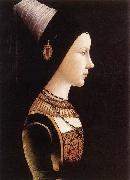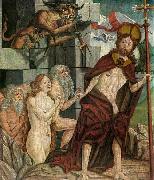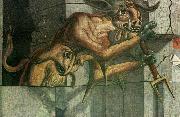PACHER, Michael Huiler la Reproduction de TableauAll PACHER, Michael Oil PaintingsAustrian Northern Renaissance Painter, ca.1430-1498 |
|||

|
|||
|
|
|||
|
||||||||||||
| PACHER, Michael Austrian Northern Renaissance Painter, ca.1430-1498 |
||||||||||||
|
|
||||||||||||
| ID de tableau:: 52210 Mary of Burgundy Mary of Burgundy c. 1490 Oil on wood, 47,5 x 35 cm c. 1490 Oil on wood, 47,5 x 35 cm |
||||||||||||
|
|
||||||||||||
| ID de tableau:: 63695 Christ in Limbo Christ in Limbo 85 x 71,5 cm Museum of Fine Arts, Budapest As a fulfillment of redemption, Christ, having broken open the gates of hell, has brought with him the pious figures of the Old Testament, holding Adam by the hand as the symbolical incorporation of the whole of humanity. Allusions to this forced invasion, a favoured incident of popular legends and mystery plays, are found even in the Divine Comedy; here it is indicated by cracked and broken stones. It is typical of medieval thinking that hell is represented as a well-guarded building of huge stones, a sort of immense fortified prison; the notions of release, heaven, enjoyment of the delights of Paradise, are conveyed by a fresh green meadow encircled by mountains and forests of fantastic shape, worthy of the imagination of a Tyrolese painter. As symbol of his triumph over death, Christ holds the banner of victory in his hand; the wounds on his hands and feet are clearly visible.Artist:PACHER, Friedrich Title: Christ in Limbo Painted in 1451-1500 , Austrian - - painting : religious 85 x 71,5 cm Museum of Fine Arts, Budapest As a fulfillment of redemption, Christ, having broken open the gates of hell, has brought with him the pious figures of the Old Testament, holding Adam by the hand as the symbolical incorporation of the whole of humanity. Allusions to this forced invasion, a favoured incident of popular legends and mystery plays, are found even in the Divine Comedy; here it is indicated by cracked and broken stones. It is typical of medieval thinking that hell is represented as a well-guarded building of huge stones, a sort of immense fortified prison; the notions of release, heaven, enjoyment of the delights of Paradise, are conveyed by a fresh green meadow encircled by mountains and forests of fantastic shape, worthy of the imagination of a Tyrolese painter. As symbol of his triumph over death, Christ holds the banner of victory in his hand; the wounds on his hands and feet are clearly visible.Artist:PACHER, Friedrich Title: Christ in Limbo Painted in 1451-1500 , Austrian - - painting : religious |
||||||||||||
|
|
||||||||||||
| ID de tableau:: 63696 Christ in Limbo Christ in Limbo 1460s Tempera on pine panel Museum of Fine Arts, Budapest Obviously, every action of the devil against Christ is hopeless and can do no harm. It is ludicrous to see him lean out from his castle at the risk of losing his balance; the fires of hell illuminate his backside with a reddish glow, while he gnashes his teeth mixed with fangs, brandishes his two-pronged fork, and makes a threatening gesture with the blunt, fleshy fingers of his other hand. His head is like that of a he-goat, on his arms there are prickles reminiscent of a bat's wings; the contours of a beak-like nose on his belly complete the phantom figure of horror created by the fantasy of the Middle Ages.Artist:PACHER, Friedrich Title: Christ in Limbo (detail) Painted in 1451-1500 , Austrian - - painting : religious 1460s Tempera on pine panel Museum of Fine Arts, Budapest Obviously, every action of the devil against Christ is hopeless and can do no harm. It is ludicrous to see him lean out from his castle at the risk of losing his balance; the fires of hell illuminate his backside with a reddish glow, while he gnashes his teeth mixed with fangs, brandishes his two-pronged fork, and makes a threatening gesture with the blunt, fleshy fingers of his other hand. His head is like that of a he-goat, on his arms there are prickles reminiscent of a bat's wings; the contours of a beak-like nose on his belly complete the phantom figure of horror created by the fantasy of the Middle Ages.Artist:PACHER, Friedrich Title: Christ in Limbo (detail) Painted in 1451-1500 , Austrian - - painting : religious |
||||||||||||
|
|
||||||||||||
| Artiste précédent Artiste prochain | ||||||||||||
|
|
||||||||||||
|
PACHER, Michael Austrian Northern Renaissance Painter, ca.1430-1498 |
||||||||||||
|
|
||||||||||||
|
CONTACTER DES Etats-Unis |








